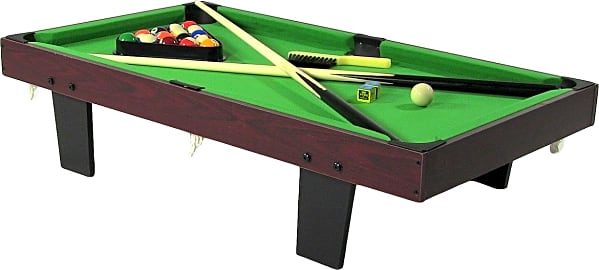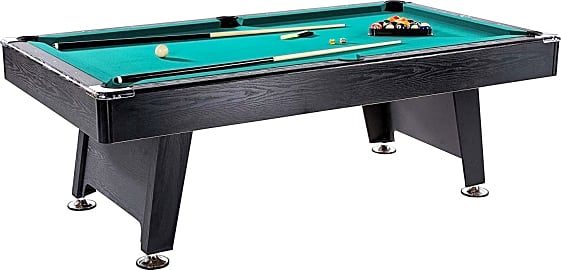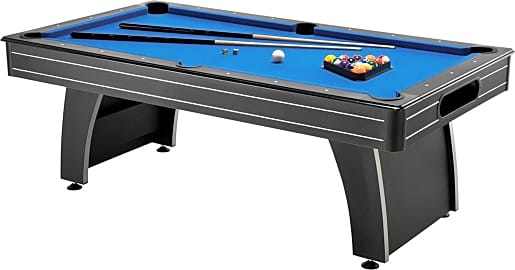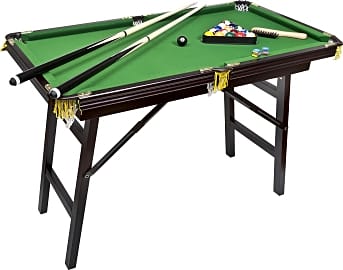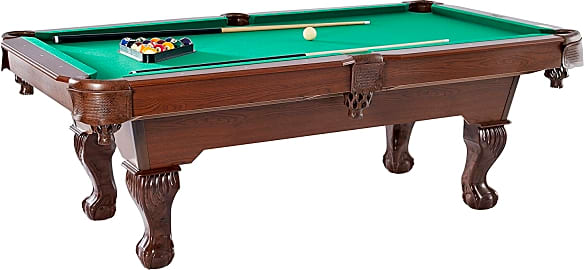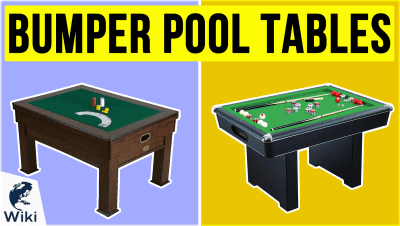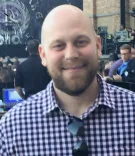The 10 Best Pool Tables

This wiki has been updated 44 times since it was first published in April of 2015. Put a pool table in your home and it will be the most popular house on the street. Whether that's good or bad is entirely up to you, but these models can provide family and friends with hours of billiards fun for years to come. Plus, they are available in sizes to fit any room, designs to match any type of decor, and at prices to meet any budget, so you're sure to find one perfect for you. When users buy our independently chosen editorial recommendations, we may earn commissions to help fund the Wiki.
Editor's Notes
April 17, 2019:
While the Brunswick Danbury was formerly our top-rated product, it was supplanted by a sister table, the Brunswick Glen Oaks. Both are fantastic tables, but we felt the Glen Oaks was a little more solidly built, and therefore more worthy of the substantial investment needed to buy either one.
If you're just shopping for kids, the Sunnydaze Decor Mini is your best bet, as it's easy for them to set up and move while also providing a relatively realistic experience. It's not the only possibility on the list, though, as the Playcraft Sport Bank Shot and Bello Games Deluxe Folding are both inexpensive ways to introduce children to the game without having to dip into their college fund to do it.
The Lancaster Gaming Company Arcade is our favorite middle-of-the-road option. It's not quite as elegant or classy as the Brunswick models, but it comes at a fraction of the price. It's still durable and plays well, so players of all ages can enjoy it — and any snobs who turn their noses up at it can simply find a game somewhere else.
A Brief History Of Billiards
Mary, Queen of Scots was famously buried in her billiards table cloth in 1587.
The origins of billiards games, which are generally referred to as cue sports, actually lie in outdoor lawn games that date back over 600 years to the Late Middle Ages. Early forms of games like croquet and golf, namely the french jeu de mail, or "game of the mallet," were popular among the royal class in France as early as the 1340s.
From France, the lawn games spread to England and Scotland. In the meantime, indoor versions of the games became a necessity for royal figures like King Louis XI because they wanted to play year-round. The original tables were laid with green cloth to simulate the grass on which the games had typically been played outdoors.
The game's popularity with the noble classes of France and England lent an aspirational air to billiards play outside of those circles. Mary, Queen of Scots was famously buried in her billiards table cloth in 1587. The game was well-known enough to be mentioned by Shakespeare in his plays, including Antony and Cleopatra, which was first performed in 1607.
In early forms of the table games, balls were pushed with a wide-ended stick called a mace, rather than struck with the point of a cue. In the late 1600s, the cue was introduced to combat the difficulty of pushing the balls when they were close to the edges of the table. Players had been flipping their maces to use their narrow-ended handles, called queues, to push the balls for some time, so the cue was developed as a more precise solution.
Initially, the raised edges of the billiards table, called banks, were used only to prevent balls from falling off the edge during a game. Over centuries of play, players realized they could use the banks to ricochet balls to their desired destinations. Thus, the bank shot was born, and table edges were intentionally constructed with materials known for their rebounding power.
By the early 1700s, the game had made its way to popularity outside of the ruling classes of France. Billiards tables could supposedly be found in most cafes in Paris by 1727. The game became increasingly popular in England in the 1800s, as the Industrial Revolution made it much easier and cheaper to manufacture equipment. Formats of billiards tables varied by regional preference, though the current form, which includes the addition of pockets around the perimeter, was fairly well-established by the 1850s.
The Anatomy Of A Billiard Table
Billiard tables are comprised of very few parts. The most important of these is the bed, which is the cloth-covered playing surface. On high-end tables, the bed is often made of slabs of slate. The slabs are typically laid with epoxy or resin between them and then sanded down to ensure a flat and seamless surface.
Home billiards tables may use slate as well, though the slabs are usually a bit thinner than those used on tournament tables. Wood is also used for cheaper and lighter tables, though it is avoided among professional and luxury models due to its tendency to warp. Plastics and other synthetics are also popular on the low-end.
Plastics and other synthetics are also popular on the low-end.
The cloth that covers the bed is usually green, emulating the grass lawns on which the game was originally played. A type of cloth used may vary depending on the desired effect on the friction of play as well as the overall quality and cost of the table. Thicker, blended felts tend to slow down the balls more quickly during play, but are preferred by bars because of their durability. High quality billiards cloths are often made from wool, which provides a smoother and faster playing surface.
Around the bed is a raised edge, usually referred to as the rails. These are cushioned on the inside to facilitate rebounded bank shots. The cushioned layer is usually made of vulcanized rubber, while the rails themselves are typically wooden. In tables with pockets, the rails are usually used to support them, and feature cutouts for the balls to fall into. Leather pouches or nets are usually used for the pockets themselves.
The body of the table is called the cabinet. Depending on the table, it is either a single solid piece or can be disassembled for transport. It is generally made of wood, with four curved legs supporting it at each corner. Many bar tables use an internal mechanism built into the cabinet to collect the balls after they've landed in one of the pockets, which are actually openings to a system of tunnels. This ensures that the balls never leave the table, cutting down on theft and loss. It also expedites the process of setting up for the next game, as all the balls are collected in a central location within the cabinet.
Games You Can Play With A Billiards Table
To this day, a wide variety of games are played on billiards tables. Generally speaking, these games can be divided into two categories, carom and pocket. Depending on your game of choice, you might choose to buy a table designed specifically for a particular use.
Depending on your game of choice, you might choose to buy a table designed specifically for a particular use.
Carom tables do not have pockets and are usually five feet wide by 10 feet long. These tables date back to the 18th century. Games played on this type of table include straight rail, the champion's game, balkline, cushion caroms, three-cushion billiards, and artistic billiards.
As we know them, pocket tables, also called pool tables, date back to the 16th century. As their name suggests, they are defined by the inclusion of pockets at various intervals around their perimeters. They typically feature six pockets; one at each corner, plus one at the midpoint of each of the long sides. The style of balls used depends on the player's game of choice, as does the table's dimensions.
Some of the games one can play on a pocket table include eight-ball, which is the most popular version of pool in the United States, as well as nine-ball, three-ball, one-pocket, and bank pool variations. Snooker is another popular pocket table game, though it is usually played on larger tables and includes 22 balls. Many other variants are played around the world.


